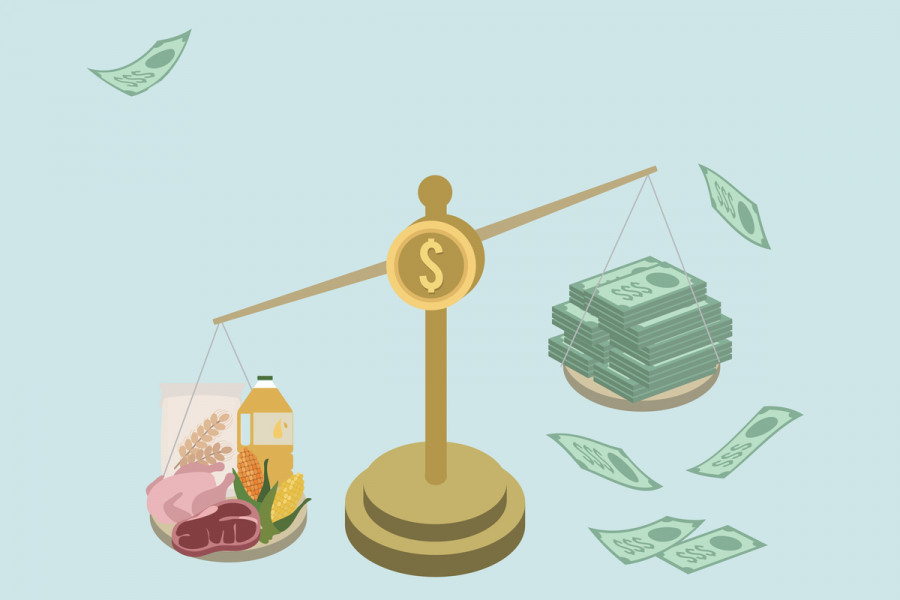Columns
Central bank independence
Inflation can be high when there is a problem in the central bank’s independence.
Ram Neupane
Every country's economy is mostly operated with a blend of two major economic policies—monetary and fiscal. It has been widely accepted that these two policies are the two wheels of a cart. Effective coordination between monetary and fiscal policies is the essential prerequisite to optimising the performance of an economy.
Steady economic growth with overall economic stability is the major concern of these two macroeconomic policies. In this pursuit, different governing mechanisms delineate the roles and responsibilities of these two cointegrated macroeconomic policies.
Fiscal policy, being formulated by several governmental agencies and legitimised through Parliament, has long inside lags and short outside lags. In contrast, monetary policy, generally being formulated by the supreme financial authority, the central bank, in most cases, has short inside lags and long outside lags. Thus, both policies have issues related to implementation lags, which can be understood as the time required to transmit the policies into action and further reactions. It means that both procedures have no perfect instantaneous transmission mechanisms, and the best way is to work in close collaboration.
Moving in tandem
Although, in the long run, both policies converge in their objectives, the case may be different in the short run. Some divergences may arise in the policy prescription and implementation as both approaches have distinct short-run targets. Fiscal policy broadly deals with the government's revenue and expenditure management. In comparison, monetary policy emphasises the stability of the overall economy. The central bank's primary concerns are stability in inflation, interest rate, exchange rate and the financial sector. Therefore, to increase the overall welfare of the economy, these policies should move in tandem.
In this context, the concept of central bank independence has emerged as a safeguard measure to direct both macroeconomic policies to focus on their respective areas. There are many approaches to defining the central bank's independence. Broadly, two types of independence can be seen—financial independence and political independence. Financial independence is also taken as micro-level independence, which includes independence in formulating its budget, setting the salaries of its staff and distribution of its profits, to name a few. Political independence is somewhat macro-level freedom of the central bank. It includes activities like appointment of board members, government representation on the board and the authority to make the ultimate decisions.
Though formal discussions of central bank independence do not have a long history, it was practised after World War I by Germany. During the 1930s, Germany was struggling through post-war recovery. Increasing government debt, supply chain distortions due to worker strikes, and huge reparation dues created financial pressures on the German economy. In this quest, the German government chose to print large quantities of unbacked currency. As the money supply increased, its real value decreased, which led to hyperinflation. Following that lesson, Germany now has the world's first and most conservative independent central bank, the Deutsche Bundesbank. Even the European Central Bank has followed the Bundesbank model of an independent central bank.
The 1970s energy crisis is a milestone when central bank independence was raised to a new height. Before that crisis, there was a strong belief in the Phillips Curve, which states that a higher price level could help reduce unemployment. However, during that crisis, it was observed that both unemployment and inflation were increasing at the same time, causing stagflation. Since then, it is assumed that governments worldwide have given more independence to their central banks to set their goals and operate accordingly.
When the central bank's independence is questioned, inflation will behave in an undesirable way. The reason behind this is that the most critical mandate of the central bank is to maintain price stability. It has been empirically tested in many economies that inflation can be high when there is a problem in the central bank’s independence. Similarly, studies also show the negative relationship between the central bank's independence and budget deficit. This may be because budget financing through fiscal measures like taxation is politically less desirable than financing through monetary instruments. A similar causality can be found between the central bank's independence and financial crisis. The greater the central bank's independence, the lower the chances of having financial trouble. Central banks are globally perceived as the rescuer institution during a crisis.
Welfare maximisation
Although it is a well established fact that a higher level of the central bank's independence will have comprehensive benefits for the entire economy, the tendency of challenging such freedom is still taking place. It is also seen that the more a central bank formulates an unconventional monetary policy, the higher the chances of its independence being curtailed. During the Covid-19 crisis, former United States president Donald Trump said that he was not happy with the Federal Reserve chairman's handling of the situation. He added that he had the right to remove him, but he would not do so. Argentina, Venezuela, Zimbabwe and Turkey are a few other countries that have suffered economic instability due to lack of coordination with their central banks. Some hiccups in the central bank's independence were witnessed in India during the tenures of former Reserve Bank of India governors Raghuram Rajan and Urjit R Patel.
Therefore, it is not be a matter of who should govern the economy, but putting focus on overall welfare maximisation. While ever-changing economic scenarios will not let policymakers find an easy way out, adequate coordination between these policies will prevent the situation from worsening. Thus, both ends need to take coordinated steps to make the situation better.




 19.12°C Kathmandu
19.12°C Kathmandu















